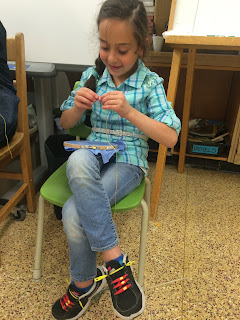It is said a picture is worth a thousand words. We believe the same could be said for a piece of art or a particular artifact. In working with our Artist in Residence, Miss. Lisa, we set out to tell stories of the past though two unique creations.
In our study about Calgary's history, we discovered that history is compiled of stories, and that the history we come to know depends greatly on who is telling the story. Knowing that the story of this place began long before Calgary became a settlement, we believed it was important to include two stories, two perspectives and two ways of representing our learning.
Inspired by the stories of the Blackfoot First Nations of this region, we made traditional rattles that included a symbol of Aboriginal cultures. Some display a sun, a medicine wheel or a tipi. Others include a significant animal such as the buffalo or the turtle.
When we learned about the first settlers of the prairies, we read many stories that helped us get a sense of what life would have been like before electricity, television and computers. We wanted to tell the story of the past using materials and artwork that would be authentic to that time period. Our first project was learning embroidery. Lots of adults thought it would be tricky for us because our fingers are so small but we showed them that these little hands can do great things!
We chose a word that represented the stories of the past and embroidered this word, along with a picture, in our own embroidery hoop. They turned out to be so beautiful, we decided to hang them in the hoops just the way they are!
Our final project was a collaborative piece of art - a quilt. Each person in our learning community created a quilt square using scrap pieces of material. The images on the squares represent different parts of history that have helped to make this land, this place and this city what it is today.
Telling stories through art was a great experience. It helped us to understand how stories of the past impact the present and can affect the future.





















































